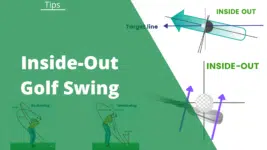There aren’t many shots that can rival the shank as a horrific mishit. Some players even argue that a golf shank is worse than a whiff (completely missing the ball).
Besides, a shank can ruin your chances of getting a low score. Not to mention, there is also the embarrassment that comes with hitting this off-target shot.
No worries, though. You can fix your shank problem with some dedicated practice and drills.
Here’s a quick primer on how to fix a golf shank. You can practice a drill trying to miss on the inside since most shanks result from impact more towards the heel/hosel. You want to train yourself to hit the ball closer to the center of the clubface. Recording your swing with your phone can also help you diagnose your shank issue.
But it’s often not so simple since there are many causes of a shank.
Read on to learn what shanks are, what causes them, and how you can quickly fix them should you ever encounter this problem. This will help you lower your score and save some face at your local golf club.
What is a Shank in Golf?
Nowhere near as desirable as a lamb shank, a golf shank is a kind of shot where players hit the golf ball with the innermost sections of the club completely missing the clubface. Usually, this means the impact is made with the heel or often in the lower hosel.
This often results in the golf ball shooting toward the direction of your playing hand. That is to the right if you are right-handed and towards the left, if you are left-handed.
Often, as the ball is offline, you can find yourself playing from the bunker or roughs because of this. If you somehow survive landing in an undesirable lie, you won’t survive the loss of height, speed, and distance that can significantly affect your score. Even worse, since the movement of the ball is in an unplanned manner, it can result in injury to other players who may be around you.
What Causes a Shank in Golf?

While it might seem like a shank can come randomly from nowhere sometimes, there is often an underlying cause whenever you find yourself shanking golf shots. Let’s take a look at a few possible things you can address to decrease your chances of shanking it.
1) Standing Too Close or Too Far From the Golf Ball
Standing too close to the ball may cause some players to take the club too far inside. This causes the club to be misaligned, resulting in a hosel/heel impact. This is most common with beginning players.
Equally, standing too far from the golf ball may lead some players to over-correct by leaning forward into the shot. This is called an early extension in golf and often leads to them shanking the golf shot too.
To fix this, simply go back to the basics of how and where to stand when swinging.
You’ll want to stand with your club head next to the ball. And the butt end of your club should point at your belt buckle. It should be 6 inches away from your thighs.
2) Poor Body Weight Placement
In some instances, players who think they are leaning too far forward may try to counter this problem by resting all their body weight on their heels.
With all the weight on the heels and the toes left hanging, the only place your body can move now is forward.
This means that players may again rock forward on the downswing, moving their club out of position and completely missing the club face on impact.
To fix this, you should balance the ideal foot placement between the heel and toe.
3) Opening or Closing The Clubface Too Much
Some players may resort to opening the club face on the opening either in a bid to correct other problems they may have developed or simply without knowing.
Doing too much of this while on the backswing and carrying on with this on the downswing may result in the hosel having first contact with the ball when impact is finally made.
At the same time, in an attempt to not miss the club face, if you close your club face too much while on the downswing, you may bring the hosel closer to the ball resulting in shanks in golf.
You can review a slowed-down video of yourself to see where the problem lies and slowly work on making the proper adjustments.
4) Hand Movement Too Far From the Body
While on the downswing, some players may move their hands too far out from their bodies. The result of this is often the movement of the club forward, causing the club to move from initial alignment and the hosel/heel to contact the ball first upon impact. Check to see you aren’t overstretching on the downswing.
5) Poor Grip on The Club
Even with the right address position, sometimes the club might move out of place if you don’t grip your club well. If your grip pressure on the club needs to be stronger, the club may sometimes slide out of place every time you swing without noticing the slight movement.
Also, poor hand placement on the club may result in the club being more forward or behind than it is supposed to be, leading to shanked golf shots.
6) Not Checking Your Swing Path
Your swing is going to determine exactly where your ball ends up on the course. An error in your technique can often be one of the causes of a shank.
A quick way to pick up technique errors is to check your swing path as often. If it is off, this may indicate a technique problem. Your swing path is simply the club’s direction upon impact with the golf club. Checking your swing path before making impact can help you know if the club is too far to the inside or outside of the ball and help you avoid the shanks.
7) Poor Standing Posture
There is so much that goes into golf posture, and any wrong positioning may be the cause of you shanking shots.
For instance, not staying in the same posture throughout the entire swing may be a reason you keep hitting shanks.
Another reason is having poor posture habits, such as having your legs too wide. Ideally, a player’s legs apart should be the same width as his shoulders. This ensures good balance and free movement when taking your shot.
How to Fix A Shank
If correcting the mentioned causes does not work, or perhaps you still don’t know how to go about curing the deadly shanks disease, don’t worry. There are a couple more fixes and drills you could use.
1) Record Your Swing
This can greatly help players who are constantly hitting shanks and need help knowing where exactly the problem lies. Sometimes you may be frustrated due to being unable to narrow down on the exact cause of your shanking golf shots.
A quick recording lets you slow down the video and accurately pinpoint the problem areas. This helps you save from frustration and time wastage as you can quickly correct errors.
2) Miss The Ball on The Inside
This is a quick and easy way of fixing a shanking error. The goal is to try and miss contact with the ball while at your address position. As a shank is mostly caused by contact upon impact being more towards the heel/hosel, this way, you can train yourself to get the ball closer to the center of the clubface, all by trying to miss.
You can use a couple of drills to practice this easy fix. Here is a good miss drill by Monte Scheinblum you can try out.
3) Go Over The Basics
Sometimes the error is simpler than you might realize. A quick run-through of basic golf, proper posture in the address position, good grip, how to hit each club, and correct swing technique can get you back on track faster than you think. This may be especially helpful for beginner golfers.
Just take your time and ensure you are doing everything correctly before continuing.
4) Take a Break
Suppose you have been going at it for quite some time and are still not getting the results you want. This is often a sign just to take a step back, relax and come back later when your mind is clear.
This is especially so with shanks. You might find yourselves making the same mistakes without even realizing it. Even worse, you may pick up more technique mistakes if you keep going. How long the break lasts is going to depend on you. It can be anywhere from going for a drink and coming back to a few days off.
A frustrated golfer is rarely a good golfer. When you come back, your mind will be more alert and you will probably get over the shanks with the newfound concentration.
Wrapping Up
Almost every golfer (even pros) will hit an occasional shank. Don’t get too hung up on trying to fix them if you’re not busting them out every round. But, the tips we gave above should help every intermediate golfer escape the dreaded golf shank. Good luck, and practice hard!
Chris's love for golf is only rivaled by his wanderlust. A globetrotter at heart, He’s played courses throughout Europe and Asia and at home in NSW, Australia. With a writing style as smooth as his golf swing, he’ll help you find the right gear to match your skill level and style. You can connect with Chris on LinkedIn.






